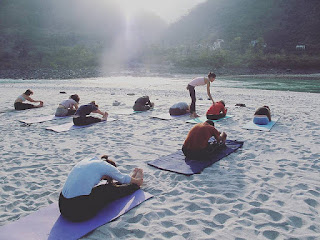What to see in Haridwar, India
Usually, we always recommend to take things slowly and spend several days to visit a city. In the case of Haridwar, since it is often a day trip from Rishikesh, we think it is better to draw a path that allows you to see all this sacred city in 24 hours!
A guide to seeing Haridwar in one day:
- a visit to the morning market; - a trip to the ghats in the day where you can take some nice pictures in the sunlight;
- lunch at one of the most famous restaurants in the area, the Chotiwala;
- a spiritual journey that touches two important temples inside the city (also accessible via cable car and minibus in a practically organized itinerary);
- return to the ghats at sunset to participate in the evening puja.
Haridwar Heritage Walk
The central market of Haridwar: Moti Bazaar
A few steps from the main ghat is an intricate network of streets full of shops of all kinds. Between Moti Bazaar, Upper Road and Jwalapur you will find every possible commodity. This area of bazaar being very frequent from locals and very little from foreigners has really cheap prices and very original products. Lose yourself among stalls selling Hindu sacred icons, textiles and Ayurvedic products, it will be worth it.
The ghats of Haridwar and Ganga Aarti: Har Ki Pauri and the others
Perfect places during the day to take beautiful photos of giant Shiva statues that rise in this area and admire the local people who relax and pray on the banks of the Ganges; in the evening a symbol of the celebration of spectacular choreographic pujas during the Ganga Aarti (ceremony of thanksgiving to the river Ganges) that is celebrated at sunset (but also, in a less spectacular way, in the morning). The main Ghat of Haridwar are 4: Har Ki Pauri is the most important, where the Ganga Aarti is celebrated and where most of the faithful decide to bathe in the cold and powerful waters of the river
Go down the great stone steps that reach the Ganges and you will see many Hindus who, holding tight to big chains anchored at the bottom to not be dragged by the current, get wet and play (literally splashing and laughing like crazy) in the waters of Mother Ganga, to purify itself.
To take part in the Ganga Aarti, check the timetable for the celebration (change according to the season) and arrive at least 15 minutes in advance or risk getting too late due to the crowd gathering on the banks. The other important ghats are the Gau Ghat where the ashes of Mahatma Gandhi and Indira Gandhi, the Ashti Parvath Ghat were dispersed where the ashes of the faithful Hindus are commonly dispersed and the Subhash Ghat near the most famous Har Ki Pauri
Eat at the Chotiwala
If you are in the ghat and market area you should definitely try the best-known restaurant in the area, the chain spread in several dining options in the Haridwar / Rishikesh area: Chotiwala. If some of the restaurants of the brand did not satisfy us, we instead enjoyed incredibly thali offered by the restaurant closest to the Har Ki Pauri, where they serve a thali so abundant to feed 2 people (not cheap but really great!) And really delicious bread. Consult the Tripadvisor page to find out more.
The most important temples of Haridwar
The Mata Mansa Devi temple is dedicated to the goddess Mansa known for her ability to satisfy the wishes of the faithful who invoke her. The temple is located on Mount Bilva Parvat. Pilgrims can reach the temple through a small trek (1.5 km one way) or with a cable car which lasts a few minutes. The interior of the temple is not overly spectacular but is very popular and full of religious souvenirs sellers. The view from the top is very beautiful, too bad that the fog often envelops the city in autumn and winter.
The temple of Chandi Devi is dedicated to a height of 208 meters on Mount Neel Parvat and is 4 km from Haridwar Railway Station. It is believed that here the Goddess Parvati (wife of Lord Shiva) killed the demons Chand and Mund in antiquity. The temple can be reached by walking (quite challenging for several steps to climb to the top) or via a cable car lasting about 10 minutes. Even this temple is more spectacular from the outside than from the inside. In the area (just 500 meters) there is also the Anjani Temple, reachable with a nice light walk.
To reach Chandi Devi and Mansa Devi temples in the cable car, you will be able to buy a package that includes both funicular tickets for 300 rupees and allows you to move between a temple and the other with an organized bus (included in the price). In this way, you will save and optimize travel times. The most convenient ticket office is Mata Mansa Devi Temple, which is a ten-minute walk from the ghats.
Overall we did not appreciate these temples too (very bare inside) but if you have the time it is worth to visit them for their great importance on a spiritual level and for the view from the top of the city and the mountains (unless there is too much fog to see something). The city swarms with many other interesting temples but the Digamber Jain temple is, in our opinion, one of the most spectacular in the area for the religious sculptures that adorn it both externally and internally. It is the only Jainist temple in the city center and it is really worth visiting for its particularly eccentric architecture.
Where to sleep in Haridwar, India
If you wish to spend a night in Haridwar, you will have several choices regarding hotels and guesthouses. The city, however, does not shine for solutions at an excellent price/quality ratio, so in principle, we recommend staying in nearby Rishikesh to save money and have accommodation with higher standards.
If you prefer to spend a night in the city, check out the Ram Lodge, suitable for those with reduced budgets. Indeed, it offers decent and spacious double rooms for 8 euros per night.
If your budget is a bit higher you can visit Hotel Krishna Ji only 500 meters from the famous Har Ki Pauri ghat where you will find comfortable and clean double rooms starting from 30 euros.
To overdo it and stay in a haveli-style residence you will have no choice but to book at the Haveli Hari Ganga, a precious boutique hotel with Spa, perfect for the most refined and demanding guests. Rooms of an exaggerated but very expensive beauty, with doubles starting from 90 euros.
How to get to Mansa Devi
The Temple of Mansa Devi can be reached in two ways: on foot or by cable car.
Walking requires an uphill one and a half mile hike. The track is sealed but the effort can be drained during the hot months. So, many people prefer to take the cable car (also referred to as rope or "Udan Khatola" as the locals call it) up and down. The first cableway starts at 7 a. m. from April to October and 8 a. m. the rest of the year The starting point is located in the city center.
How to visit the Temple of Mansa Devi
Devotees who visit the temple usually like to take prasad (offerings) for the Goddess. There is no shortage of vendors, or where you boarded the cable car or out of the temple. Expect to pay between 20 and 50 rupees for flower dishes and bags containing a coconut and flowers. The entrance to the temple is also lined with vendors selling everything from jewelry to music.
Inside the temple, you will reach the footprints of the Goddess.
Give some of the prasad to the pandits (Hindu priests) and you will receive a blessing. However, note that these pundits are very hungry for money and are known to openly request donations (with threats that desires will not be met if they are not fulfilled).
From there, you will be amassed in the sanctum sanctorum where the idol of the Goddess resides.
The rest of your prasad will be taken and you will be given coconut pieces in return. Quickly express a wish to the Goddess before she is again gathered forward.
At the exit, you will find idols of other gods and goddesses (accompanied by enthusiastic pandits) to whom you can also pray.
For the fulfillment of desire, tie a thread to the branches of the holy tree located in the temple complex.
Tips for visiting the Mansa Devi Temple
The temple becomes very crowded during the pilgrimage season (from April to June) and it is best to start early. If you go later and choose to take the cable car, you will also have to wait hours on the line if you do not pay extra for a premium VIP ticket
.
The downhill walk offers panoramic views of Haridwar. Be aware of the monkeys, and the men dressed as monkeys! (When I visited, there were men dressed as Lord Hanuman, who made money by giving the devotees a tap on the head with their bat).
There is another temple at the top of the hill, the Temple of Chandi Devi, which can also be visited by cable car or bus from the Mansa Devi Temple.
You can buy combined tickets for both.
Kumbh Mela
Haridwar is one of the places where the Kumbh Mela is celebrated every twelve years. In the Hindu legend, both gods and demons formed an alliance to create the nectar of immortality, Amrita. When one of the gods appeared with the urn (Kumbh) with the nectar, the demons snatched it, spilling four drops of this nectar on four places: Nasik, Ujjain, Haridwar, and Allahabad. It is for this reason that every three years a Kumbh Mela is celebrated in each of these four places. It is one of the greatest pilgrimages in the world in which the faithful purify their sins.
Today in the morning after breakfast, we have approached Rishikesh, which is the last town before entering the Himalayan mountains. It is a place where you can breathe a very calm atmosphere and that is full of small Ashrams (temples to stay and practice meditation and yoga at the hands of priests and gurus). There is a somewhat spiritual atmosphere and it is a pleasure to walk in total tranquility through its streets.
In the afternoon, we have toured through Haridwar. The city is full of Shadhus, highly respected people in traditional India, they are beggars by vocation and live exclusively from the alms they receive.
The environment around the river is amazing, full of people bathing as mere entertainment and others doing their prayers, etc. After we have attended the Aarti ceremony, one of the moments covers our trip. The river begins to fill with spectators as two hours before and street vendors who offer all kinds of merchandise to make your stay during the most enjoyable ceremony ... As dusk begins the priests with their songs and blessings, people bathe in the river and This is filled with floral offerings with incense that we made and we let them go, little by little, the flow ... There are pilgrims coming from all over India: Delhi, Bombay, Calcutta ... the environment surrounds you and we live unforgettable moments.





























